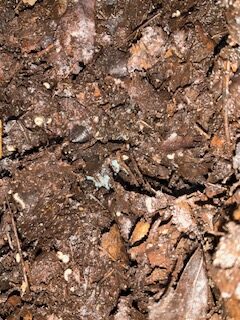
Hello,
@Nov 2/23 I’ve been cooking some Leaf Mold since last fall to use in an area where I had to take a tree out this fall. (verticillium). I dug up all the plants around the tree in October and replanted them with the leaf mold in the hole and around the plant. Nov 2. When I was finishing up, I noticed LOTS AND LOTS of little white worms. I scraped off as much of the Mold as possible, but I’m worried now about all the stuff that is dug in. 1-Do you have any idea if these teeny tiny worms are going to damage my plants? 2-Do you think possibly they will freeze and die over the winter. Any advice would be useful. Some of my favourite plants are in this area. Thank you for any help. Mercedes
Thank you for contacting the Toronto Master Gardeners.
It’s a bit tricky to get a full sense of the white worms from your picture. Some look curled – more grub-like and others look longer and thinner – more like ‘pot worms’.
Pot worms (also called Enchytraeids) are skinny, translucent and help to decomposing organic matter. They pose no risk to your plants.
Grubs are thicker, grey/white with a brown/rusty head, curl up at rest and are the larvae of beetles. There are many types of beetles and therefore many types of grubs. Some beetles can be bothersome for your plants, feeding on root, stem and leaf tissue. Japanese beetles, chafers and June beetles are some examples. Grubs bury themselves in the soil and overwinter, so freezing temperatures will not kill them. In the spring, grubs migrate closer to the soil surface and pupate into beetles, which will emerge in late spring or summer.
This website has images of several types of white worms and may be helpful to compare with what you are seeing in your soil.
It sounds like you have gone to significant lengths to remove soil possibly contaminated with verticillium wilt and replanted some of the pre-existing plants. If it turns out your white worms are grubs, good gardening practices such as ensuring your plants have adequate light, water, nutrients and air circulation will help them to survive possible damage by an insect pest.
Beginning next spring, inspect your plants for signs of pests or damage, on a regular basis. This will help to catch any problems early. This page from the Missouri Botanical Garden discusses the management of beetle infestation. Please note the pesticide mentioned on this site is not registered for use in Canada. If you determine you have grubs and see damage to your plants, please reach out to the Toronto Master Gardeners again and we can provide advice regarding specific pest management.
On the other hand, maybe these white worms are benign and just helping to aerate and decompose soil organic matter and will benefit your garden.
Best of luck!
Nov. 4/2023

